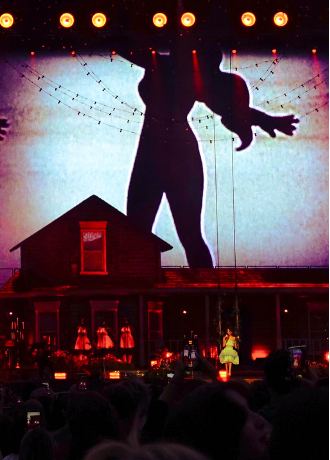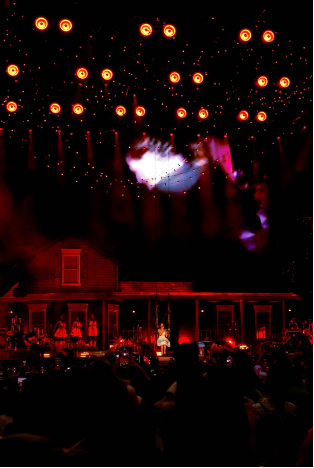Article and Photos by
Paula Martín González
When Lana Del Rey released Born to Die in 2012, she didn’t just debut an album—she introduced a cultural shift. Lana introduced a fresh vision of pop into the music scene, influenced by icons such as Marilyn Monroe and Elvis Presley (both of whom lived fast and died young). Mixing influences from hip hop, baroque pop, and Americana aesthetics, the record became a blueprint for the “sad pop” genre that would later inspire artists like Billie Eilish or Lorde.
With cinematic videos, retro visuals, and melancholic storytelling, Lana shaped the Tumblr-era identity of a generation. Her soft, nostalgic voice perfectly complemented themes of love, loss, addiction, and fragility, turning Born to Die into one of the most influential records of the 2010s.
Beyond its unique style, the album stands out for its lyrical depth and striking music videos, which combine dark and romantic narratives with a cinematic, melancholic aesthetic. Tracks like Born to Die, Video Games, National Anthem, and Summertime Sadness reflect complex relationships, fleeting loves, and the struggle between desire, power, and vulnerability. Each song becomes a universe that reinforces Lana’s vision of life, death, and the beauty of the ephemeral, solidifying her influence on contemporary pop music.
Born to Die
The title track set the tone for the entire project: a dark, almost apocalyptic ballad narrating an abusive, yet passionate, relationship destined to fail. It perfectly captured the feeling that we are all born to die, so we should embrace life while we can.
Lyrically, the song established Lana’s signature thematic mix—surrendering to desire and fleeting joy, even in the face of despair:
Keep making me laugh—let's go get high
The road is long, we carry on
Try to have fun in the meantime
She also notably references Lou Reed’s "Walk On The Wild Side", framing the cinematic ideal of letting go: "Let me kiss you hard in the pouring rain." The music video’s symbolic car crash, ending with her blood-covered partner carrying her in his arms, served as a devastating visual representation of the album’s dark core.
Video Games
Often considered the first single, "Video Games" blended baroque pop balladry with a powerful retro aesthetic. The song instantly became a reference point for sad pop and even earned the Variety Decade Award in 2021.
The lyrics recall a relationship built on shared nostalgia, but they also hint at deeper issues:
Swingin' in the backyard, pull up in your fast car I'm in his favorite sundress, watching me get undressed
The chorus delivered the album's most iconic lines, capturing the perfection found inside a dysfunctional bubble:
Heaven is a place on Earth with you
The self-made music video, combining personal clips and other visuals, perfectly introduced the world to the bittersweet, independent persona Lana had created—a woman who used to sing in old clubs, now living for the fame but prioritizing her own peace.
National Anthem
More than just a song, the "National Anthem" music video was an event. Paying direct homage to Marilyn Monroe and John F. Kennedy, the visual reflected on materialism, power, and the dark side of the American dream.
Lana's lyrics were blunt about the allure of status and wealth:
Money is the anthem of success
She explored the exclusive world of the upper echelon and the idea of "excessive buying, overdose and dying". The song, which blends hip hop, electronic sounds, and elements of the U.S. national anthem, even links to F. Scott Fitzgerald’s The Great Gatsby, referencing a life of reckless abandon enjoyed by the rich.
The ending dialogue, written by Lana herself, provided a jarring contrast between happiness and the sudden, unexpected tragedy that defined this high-stakes romance.
Summertime Sadness
Released as the fourth single, "Summertime Sadness" became one of Lana’s most famous tracks. The term became shorthand for the melancholy we feel when a brief relationship, or even just the season, is coming to an end.
Musically, the track features a catchy melody built on strings and percussion, enhancing its dramatic and nostalgic atmosphere. Lyrically, Lana uses fire imagery to emphasize life's impermanence: fleeting, intense, yet destined to extinguish.
The lyrics express eternal devotion, juxtaposing distance with connection:
Think I'll miss you forever Like the stars miss the sun in the mornin' sky
The retro-styled video, which sparked various interpretations ranging from a tragic love story to a tribute to suicide, cemented the song as a poignant exploration of love, loss, and the fleeting beauty of life.
The Legacy
Though initially met with harsh criticism, Born to Die achieved a monumental legacy: it spent over 600 weeks on the Billboard 200—making it one of the longest-charting female albums in history.
More than just a record, it became a cultural phenomenon, shaping music, aesthetics, and identity throughout the 2010s. By weaving vintage romance with modern darkness, Lana Del Rey wasn’t just "born to die"—she was born to change music forever.

